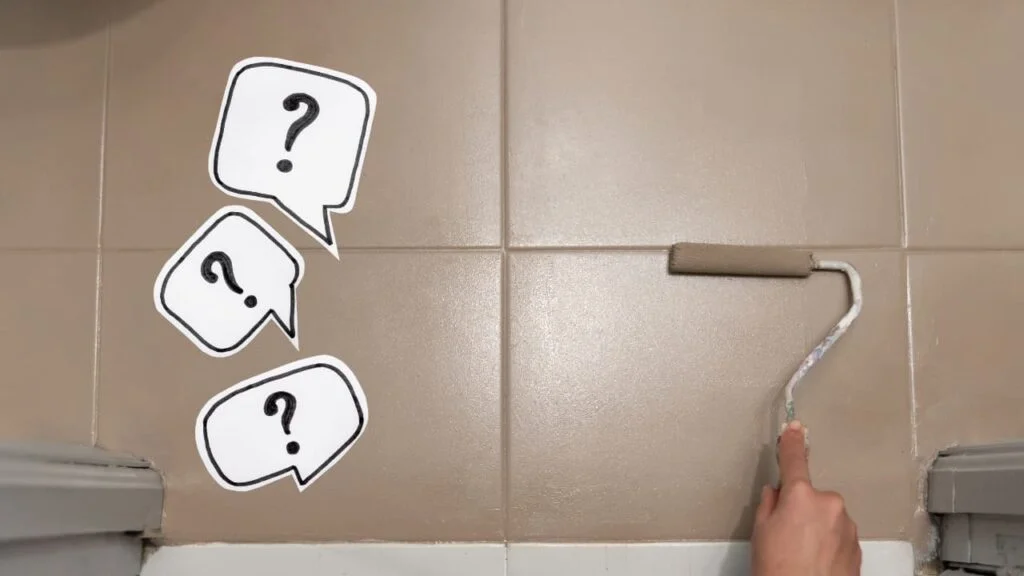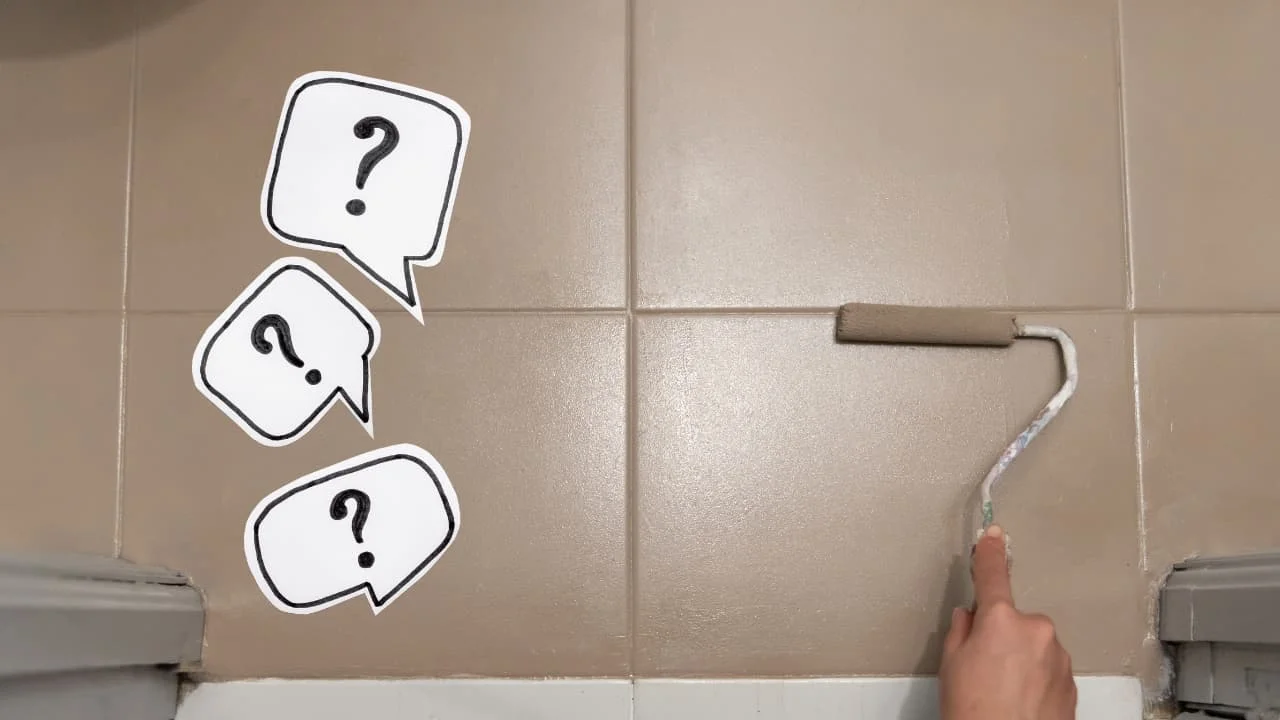A bathroom is one of the most important rooms in a home and it’s important to make sure that it looks nice, inviting, and comfortable.
One of the best ways to do this is by painting tiles in the bathroom. But is it possible to paint the tiles in the entire bathroom yourself? How should you go about doing it? What types of tiles can be painted? What are some common mistakes to avoid when painting bathroom floor tiles?
In this blog, we will answer all these questions and more. We will also provide expert tips on how to paint your bathroom tile floor so that you can achieve the desired look without any hassle. Read on to learn everything you need to know about painting tiles in a bathroom.
Can You Paint Tiles in a Bathroom?💭
Yes, tiles in a bathroom can be painted to refresh their appearance. Painting tiles is a cost-effective way of upgrading a bathroom’s look without doing a full renovation.
Ensure that the tile floor is clean, free of any soap residue, and dry before starting the painting process. It’s recommended to use high-quality tile paint and a primer specifically designed for surfaces that can be slippery. The primer helps the paint stick to the tiled surface better and provides a consistent finish.
Additionally, it’s advisable to space out the painting to allow each layer to dry thoroughly for the best results. For best results, consult a professional before painting tiles in a bathroom.

Table of Contents
Introduction
If you’re wondering, “Can I paint my bathroom tiles?” the answer is yes, you can indeed paint bathroom floor tiles to give them a fresh and updated look. Painting tiles can be a cost-effective alternative to replacing them altogether. Before starting the project, ensure that the tiles are clean and free from any dirt or grime.
Additionally, it’s crucial to choose the right type of paint suitable for tiles, such as epoxy paint, which provides durability and resistance to moisture. With the right preparation and the correct paint, you can transform your bathroom by simply painting the tiles, giving your space a whole new lease on life.
Painting bathroom floor tiles is a cost-effective way to give your bathroom a refreshed look without breaking the bank. By following some simple steps, you can transform outdated or worn-out tiles into a modern and updated look that suits your style.
But before you start painting bathroom tile, it’s important to understand the types of tiles that can and cannot be painted, as well as the right tools and techniques for the job. By properly preparing wall tiles and selecting the right materials, you can achieve professional-looking results that will last for years to come.
Understanding the Concept of Painting Bathroom Tiles
Painting bathroom floors is a budget-friendly alternative to replacing them. However, it requires careful planning and execution. The right kind of paint and primer is crucial for good results to paint shower tile.
Additionally, preparing the tiles properly by cleaning, sanding, and priming them ensures that the paint adheres well. Using a brush or roller to apply multiple thin coats of paint uniformly will give shower tile an even finish. It’s important to allow each coat to dry entirely before applying the next one.
Finally, sealing the painted tiles with a clear water-resistant sealer provides protection against moisture and prevents peeling or chipping.
Pros and Cons of Painting Tiles in a Bathroom
When considering whether to paint bathroom tiles or just replacing tile or not, it’s important to weigh the pros and cons.
One significant advantage of painting tiles is the cost savings compared to replacing them entirely. It’s also a great way to update the look of your bathroom without spending a fortune.
However, there are some downsides to consider when painting tile, as well. Painted tiles may be more prone to chipping or peeling compared to their original state, resulting in reduced durability over time. Additionally, your color options may be limited depending on the type of paint you choose.
Proper surface preparation is key to ensuring that the paint adheres well, and it’s always wise to consult with experts or professionals for advice and recommendations before starting any DIY tile painting project.
Factors to Consider Before Painting Bathroom Tiles
When it comes to painting bathroom floors, proper surface preparation is key. Before setting out to start your DIY tile painting project, there are several important factors to consider.
Firstly, check the condition of the existing tiles to ensure that they are suitable for painting. Secondly, certain types of tiles, such as ceramic or porcelain tiles, are more suitable for painting than others.
Additionally, choose a high-quality paint that is specifically designed for tile surfaces and consider the maintenance required after painting and how long the painted tiles will last before needing touch-ups or repainting. By taking these factors into account, you can ensure successful and long-lasting results from your floor tile painting project.
Types of Tiles That Can Be Painted in a Bathroom
Tiles are a popular choice for bathroom walls and floors due to their durability and ease of maintenance.
However, if you’re looking to add a splash of color to your bathroom, you may be wondering if it is possible to paint tiles. The answer is yes – but the type of tile you have will determine the best way to go about it.
Glazed ceramic tiles can be painted with special ceramic tile top paints that are available in a variety of colors. Porcelain tiles can also be painted, but they require a primer before painting. Vinyl tiles can be painted using an oil-based primer and paint.
As for natural stone tiles, these should not be painted with acrylic latex paint at all, as the paint may damage the surface over time or cause discoloration.
Step-by-Step Guide to Painting Tiles in a Bathroom
To ensure a successful tile painting project in your bathroom, it’s essential to follow a step-by-step guide.
First, prepare the tile surface by cleaning it thoroughly and sanding it lightly to remove any glossy finishes. Next, apply a primer that is suitable for tile surfaces, and allow it to dry completely.
Once the primer has dried, use a paintbrush or roller specifically designed for painting floor tiles, to apply your chosen paint. Be sure to let the paint dry completely between coats and check the wall tile for any visible imperfections before applying another coat.
After applying the final coat of paint, wait at least 24-48 hours before using the painted tile in your bathroom, shower stall, or tub to allow the paint to fully cure.
Finally, apply a sealant over the painted tiles to protect them from moisture and improve their durability. By following these simple steps, you can transform the look of your bathroom floors without having to replace them entirely.
Common Mistakes to Avoid When Painting Bathroom Tiles
Painting tiles in a bathroom can be a great way to add a new look without having to replace the entire tile.
However, it is important to take into account the proper preparation and application techniques in order to ensure the best outcome. One of the biggest mistakes people make when painting tiles is not using the right primer before painting.
It is also important to sand and clean the tiles properly before applying paint, as this will help ensure better adhesion of the paint. To ensure the longevity of your painted tiles, you must use durable paint specifically designed for tile surfaces.
Finally, don’t forget to apply a sealant coat after painting which will protect the surface from water and mildew damage. With these tips from experts, you can easily give your bathroom an updated look with painted tiles!
Maintenance Tips for Painted Bathroom Tiles
Painting tiles can be a great way to update the look of any bathroom. With the right paint and primer, you can easily give your tiles a fresh new look.
However, it is important to take certain steps to ensure that the tile paint job itself is done properly. Before painting, make sure to clean and sand the tiles for a smooth finish. Then, apply several thin coats of paint for even coverage.
Once the paint has dried, seal the painted tiles with a clear, waterproof sealant. Finally, keep your newly-painted tiles looking their best by regularly cleaning them with gentle soap and water.
Following these tips from experts will help you achieve beautiful results when painting tiles in your bathroom!
FAQs About Painting Bathroom Tiles
When it comes to painting bathroom tiles, many people have questions about the process.
One commonly asked question is what type of paint should be used. It’s important to use paint that is specifically designed for tile surfaces, as this will ensure a durable and long-lasting finish.
Additionally, you’ll want to choose a paint that is water-resistant and mildew-resistant, as bathrooms are often prone to moisture and humidity. By selecting the right type of paint, you can ensure that your painted bathroom tiles look great for years to come.
Frequently Asked Questions
What kind of paint do you use on bathroom tiles?
When painting bathroom tiles, it is best to use specialized tile paint. This type of paint is designed to be waterproof and resistant to mold and mildew growth. You may also need a primer, sealer, and grout paint in order to fully protect your tiles.
It is important to follow the instructions carefully when painting your tiles, as this will ensure the best results and prevent any damage.
Can you just paint over the bathroom tiles?
Yes, it is possible to paint over bathroom tiles, but there are some steps you should take first. The surface of the tiles must be thoroughly cleaned and sanded to ensure that the paint adheres properly.
A primer should also be applied to accent tiles before painting to ensure better coverage. It is important to use a bathroom-specific paint that is resistant to moisture and condensation. Finally, seal the painted tile with a clear sealer for added protection.
By taking these steps, you can successfully spray paint all over bathroom tiles and give them a brand-new look.
Conclusion
Painting bathroom tiles is a budget-friendly and effective way to give your bathroom a makeover.
However, it’s important to understand the pros and cons and take certain factors into consideration before embarking on this DIY project.
While it’s not recommended for all types of tiles, if done correctly, your painted bathroom tile shower tiles can last for several years with proper maintenance.
Follow our step-by-step guide to avoid common mistakes and keep your painted bathroom tiles looking fresh and new. Found this blog helpful? Share it with your friends on social media!

